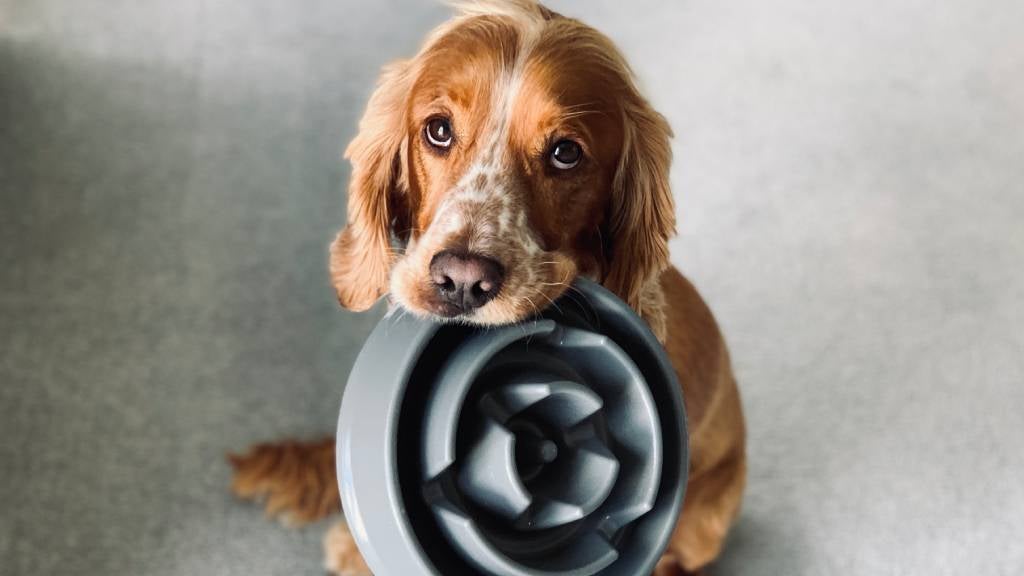Picture this: your sweet pup is happily tucking into dinner, when suddenly they start growling. A dog growling while eating can be worrying, but you’re not alone, many pet parents experience this with a food possessive dog.
This behaviour is called resource-guarding. It’s an instinct-driven reaction rooted in fear, not bad manners. The good news? With patience and the right approach, you can teach your dog to feel safe and calm at mealtimes. In this guide, we’ll explain what resource guarding in dogs really means, and share a step-by-step, training plan to manage food possessiveness.
1. Safety first: When to call a professional
If your food-possessive pup has ever bitten and broken skin or shown severe aggression, stop and contact a veterinary behaviourist or certified trainer immediately. Cases involving serious dog food aggression should always be handled with in-person, professional help.
This guide is designed for mild-to-moderate dog guarding behaviour only. Trying to handle severe cases on your own could put you, your family, and your pup at risk. It may also be worth visiting your vet first. Sometimes signs of resource-guarding in dogs can be linked to underlying pain, illness or anxiety and a check-up helps rule out medical causes.
Asking for expert support doesn’t mean you’ve failed, it means you’re putting your dog’s safety and wellbeing first.
2. Understanding the "why": The science behind resource guarding
So, what is resource guarding in dogs? It’s when a dog becomes defensive over something valuable – most often food, but it can also be toys, beds, or even people. A resource-guarding dog isn’t trying to dominate you, they’re acting out of fear or anxiety. For many, it’s a survival instinct: in the wild, protecting food means survival. For others, it may come from past experiences of food scarcity.
The most effective way to change this behaviour is through desensitisation for dogs and counter-conditioning (DSCC). These methods don’t just suppress growling, they change the way your dog feels. Over time, your pup learns that a person near their bowl means something positive is about to happen, not that food will be taken away.
3. Your step-by-step training plan
Helping a food-possessive dog takes time. Don’t rush the process, progress may take weeks or months. The aim is to build trust and reduce stress, and unleash their happiness. Here’s how to get started:
- Stage 1: The presence game: Stand a safe distance away while your dog eats. This will teach them that your presence isn’t a threat.
- Stage 2: The treat toss: From that safe distance, toss a high-value treat (like chicken) towards the bowl, then walk away. Your dog begins to connect your presence with positive rewards.
- Stage 3: The slow approach: Take a step closer, toss a treat, then step back. Repeat over multiple sessions, gradually closing the gap. This slow pace is key to stop resource guarding safely.
- Stage 4: The hand-off: Stand next to the bowl and drop treats directly into it. Your dog learns that your hand near the food is a good thing, not something to be scared of.
- Stage 5: The bowl touch: While dropping treats, briefly touch the side of the bowl with your other hand. Keep pairing the touch with rewards.
- Stage 6: The bowl lift: Once your dog is comfortable, lift the bowl briefly, add something extra tasty, then return it immediately. This helps ease dog food aggression by teaching that the bowl leaving means it comes back better.
Training a food-possessive dog is about trust, not dominance. Celebrate small wins, and don’t move forward until your pup feels completely comfortable at each stage.
4. Management in multi-dog homes
Things can get more complicated when a dog guards food from other dogs. In this case, it’s not just fear, it’s real competition.
As a rule of thumb, try to feed dogs separately in different rooms, crates, or areas. This prevents conflict and keeps mealtimes calm. Teaching your other dog a strong “leave it” cue can also help manage dog guarding behaviour. But if fights break out, professional help is strongly recommended, inter-dog guarding can escalate quickly.
Many homes with more than one dog face this issue, so don’t feel discouraged. A little structure goes a long way in keeping the peace.
5. How pet insurance provides a safety net
Even with the best training, accidents can happen. A bite incident happens, whether from your dog injures another pet or themselves from resource guarding or dog food aggression – it could mean unexpected vet bills. These costs can be significant. That’s where pet insurance may come in handy with alleviating the cost of vet bills from accidents or injuries. Consider whether Buddy Dog Insurance may be something suitable for your situation.
Frequently Asked Questions ( FAQsFrequently Asked Questions )
We know living with a food possessive dog can feel stressful, and you might still have a few questions after reading through the training plan. You’re not alone, many pet parents wonder the same things. Here are answers to some of the most common questions about resource guarding in dogs and how to manage it safely.
How do I stop my puppy from guarding their food?
For puppy resource guarding, prevention is better than cure and we need to set up our dogs for success. Drop treats into their bowl while they eat so they learn that people nearby mean bonus rewards.
How long does it take to fix food aggression?
Every dog is different. Fixing dog food aggression can take weeks or months, depending on the dog and your consistency.
What kind of treats should I use for training?
Use high-value rewards, cooked chicken, or freeze-dried meat usually work best for desensitisation for dogs.
Is it my fault that my dog is resource guarding?
Of course not! A resource guarding dog is acting on instinct, not poor training. What matters most is supporting them with the right approach.
4 Nov 2025

